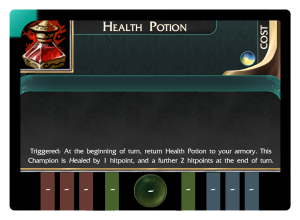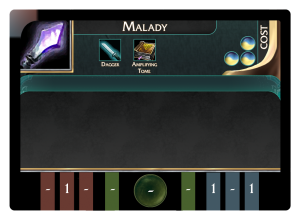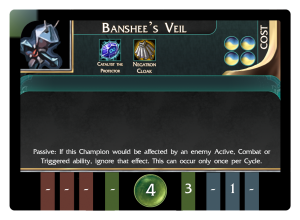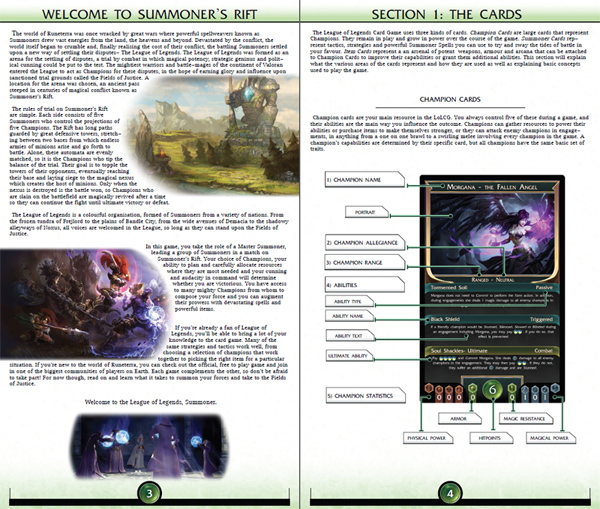Disclaimer: LoLDDCG is an independent fan project, it is unaffiliated with Riot inc. or any employee of Riot inc. Use of Riot’s graphics is intended for the purposes of prototyping and makes no attempt to challenge ownership of those graphics. All original graphics, system and design are displayed under a CC-BY-NC licence. League of Legends is (c) Riot inc.
This week’s work in preparation for the first alpha tests has mostly been producing the set of item cards. All up I built 56 items this week. I’m not sure if all of these will make it into the initial release, but they provide a good baseline set from which to work. In that light, this week I’m going to talk about how items work to provide gameplay for the LoLcg
First, there are a few major conceptual differences between the card game and videogame items. The main one is that players can only have 3 items at any one time, so choosing which items to buy in which order is far more important.
Second, items are generally more powerful and more expensive by unit- a longsword in the card game will provide a far higher level of power than a longsword in the videogame, and this is multiplicative- a champion with 2 big items in the card game is more or less equivalent to a champion with 6 items in the videogame.
 Health potion restores over 50% of many Champions’ basic hitpoints
Health potion restores over 50% of many Champions’ basic hitpoints
This was done for two reasons. For one, the numbers in the game have been kept low and simple- an item in LoLCG cost between 1 and 6 ‘gold’, while items in the videogame can cost anywhere between 35 and 1600. So if you take the health potion and needlessly large rod, which cost these amounts in both games, a health potion in the card game has to do a lot more than a health potion in the videogame to be worth what you’re paying for it- it’s a consumeable that costs half as much as a basic item like a longsword, not one tenth as much.
The same sort of idea is true across all items. Weaker items are generally stronger than their equivalents when compared to bigger items. Since the base stats of champions don’t scale innately in the card game, items are the only way your champions are going to get stronger. I felt it made sense, then, that their impact is comparatively more significant in raw terms as well.
For two, items in this game provide the same kind of complexity that card subtypes provide in other games. In Magic,, many cards will have synergistic effects with specific subtypes of creature or spell. In Netrunner, subtypes of program determine how they interact with each other and how they can be interacted with by other effects. While this is rarely absolutely critical to the effectiveness of a card, good players keep track of what their opponent is capable of and work around it using these subtypes as guidelines
In LoLCG this same functionality is provided by statistics. Just as in the videogame, if your opponent is stacking physical damage you want to build armor, if they’re stacking magic damage you want magic resistance, and if they’ve got a balanced output or true damage you need to build health.
 The rightmost statistic vaguely represents magic penetration and is quite rare, making malady a valuable synergy item
The rightmost statistic vaguely represents magic penetration and is quite rare, making malady a valuable synergy item
Not only this, but when attacking Champions sometimes receive a ‘synergy’ bonus that replicates multiplicative scaling in the videogame. A Champion with three points in a single physical statistic will deal three damage, but one with a single point across all three stats will deal four damage.
By limiting item space to 3, a champion cannot simply itemise a bunch of small items perfectly tailored to their position. They need to make hard choices and upgrade their items with more expensive advanced items in order to fit in some more stats. Gamers familiar with tower defences will understand this kind of tension. While on the surface it would be more efficient just to spam an entire TD map with low level turrets than upgrade a few to high level, the amount of prime real-estate on the map is limited, and upgrading towers with synergistic effects near to each other yields great results (an upgraded slowing tower near to an upgraded splash damage tower is going to do more than if it were next to a long row of un-upgraded ones, only a couple of which get the extended firing time granted by the slow.). This limit is enforced more harshly here- you only have three spots to put your towers on, so you better make sure they’re the right ones for the specific challenge your opponent presents you with.
 Like in the videogame, banshee’s veil provides a good, but expensive, way of dealing with champions who can blow you up with one ability
Like in the videogame, banshee’s veil provides a good, but expensive, way of dealing with champions who can blow you up with one ability
____________________________________
Onto the items themselves
The core set has most of the basic items in the game. Currently the only ones that are excluded are vision wards (not sight wards) and some of the tier 2 AD items (cloak of agility and recurve bow), for a total of 20. On top of this there are 36 of the advanced items in the game, mostly simpler ones that fit into the alpha ruleset neatly.
Because of the way the economy of the game balances out, Champions will often only get to one large item in a game, sometimes not even that. Champions are also more likely to have to build balanced stats since the cardgame doesn’t take into account mechanical skill- no matter how good you are, if you build all damage you’re going to blow someone up and then get taken down in short order. Since one big item for damage is plenty and every champion has to be able to stand their ground on their own, I expect to see a little more hybridisation in terms of what items get bought. Carries will need to itemize some defenses, tanks and supports will need to itemize some damage stats. This sort of balance also means I can give big items some more powerful or wierd effects since there won’t be that many floating around a game.
 Rod of ages has a particularly complex effect that I tried to avoid including. Since you’ll rarely see more than one in a game, however, it’s justifiable
Rod of ages has a particularly complex effect that I tried to avoid including. Since you’ll rarely see more than one in a game, however, it’s justifiable
I’m hoping that this will also make building champions feel a bit more unique on a game by game basis. Champions will likely have a signature item that perfectly synergises with their ability and statistical kit that they want to build towards. Unlike in the videogame however, this will be the only completed item they get over the course of the game, so a morgana might have a zhonyas hourglass while a twisted fate has a lichbane, instead of both having a zhonyas, lichbane and deathcap as they would at the same stage of the videogame. This is one of the things I’m most eager to see come out through playtesting, whether this more rigorous itemization can make up for the loss in individual character the champions incur from being simplified for the card format.
___________________________________
For another preview, last week was mostly spent building up the first draft of the playtester’s rulebook. When testing games and rulesets with distributed testers (ones you don’t have direct, personal access to during tests), I think that you need to go to a lot of effort to get the aesthetic feel of the game right, since people who aren’t specifically trained to be able to ignore those things will often get tripped up when working with low-fidelity prototypes. I take this philosophy even to doing rules, making sure rulesets are well formatted, presented and accompanied by diagrams and examples, just as in a published rulebook. This also has the upside of making playtesting a more pleasurable experience and, since I’m not able to pay testers, will make it less likely I get a dropoff in testing.
That’s it for this week. Playtesting draws ever closer, I’m hoping to begin recruitment around the second week of may. If you’d like to get involved, please subscribe and you’ll be the first to hear when the doors open!


